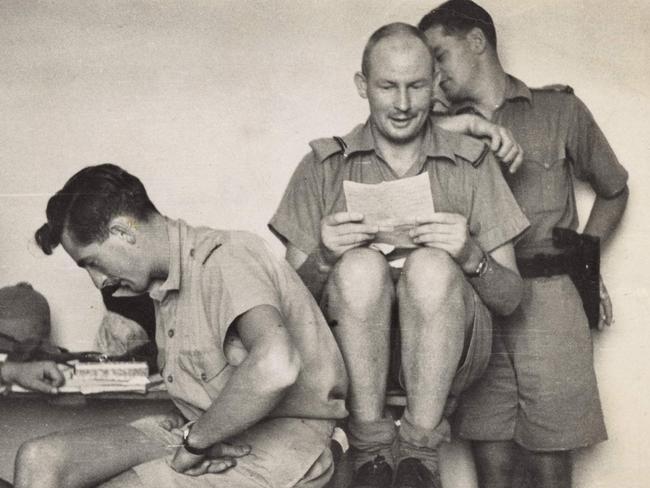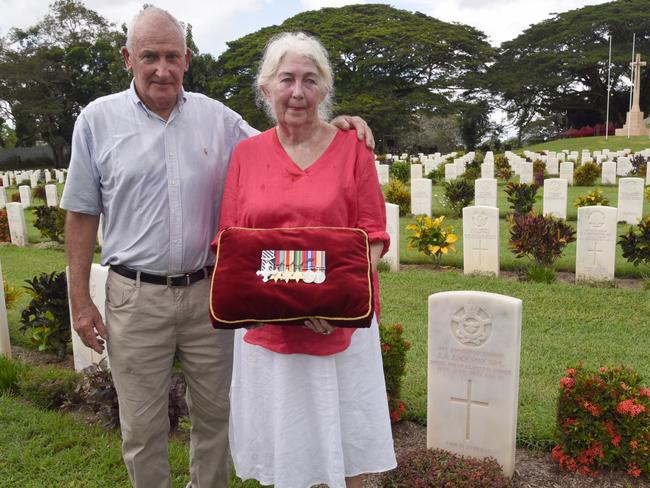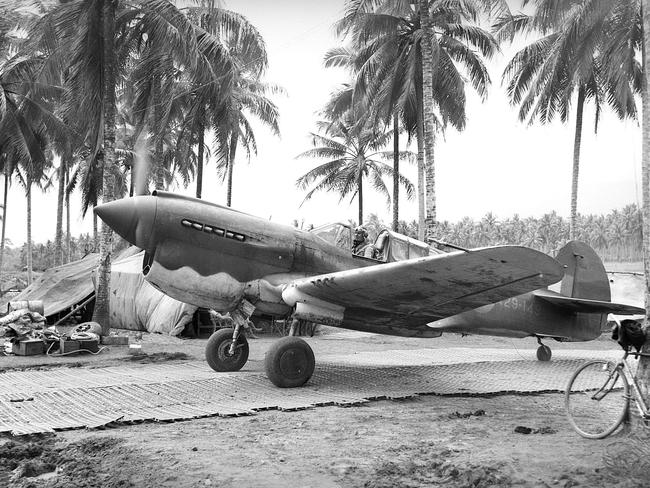The story of John Jackson, who led a tiny band of men in a 44-day battle against the Japanese in PNG
A FEW weeks before the Kokoda battle began, an Aussie pilot led a small band of undertrained men in a 44-day battle to hold off invading Japanese forces.
National
Don't miss out on the headlines from National. Followed categories will be added to My News.
TODAY, a long-awaited spotlight will be shone on one of the most important and heroic stands in Australia’s darkest hour — and on the man who made it happen.
The episode is the desperate 44-day struggle by a few undertrained, inexperienced and outnumbered Aussie pilots to hold off invading Japanese forces in Papua New Guinea, weeks before the famous ground battle of the Kokoda Track began.
And the man is Squadron Leader John Jackson, an unlikely hero — but in the words of his daughter Patricia, “the right man for the right time”.

Jackson is among a number of little-known, lesser-sung Australians whose efforts against Japan before, during and after Kokoda are being recognised in this 75th anniversary year of the campaign in am impassioned Anzac Day address by Governor-General Sir Peter Cosgrove at the cemetery in Port Moresby where they now lie.
They include Sydney’s Marie Craig — the only woman buried at Bomana Cemetery.
She was an air evacuation nurse whose plane went down, killing all 27 patients and crew aboard. The wreckage was not found until 1970.
There’s a 66-year-old Merchant Navy surgeon, Charles Tunstall, killed in an air attack — and at the other end of the scale young men like 19-year-old Privates Grenville Harold Lewis — a 19-year-old toymaker by trade, fatally shot in training before even facing the enemy — and Kenneth John Hastings a watchmaker from Ipswich killed in combat.

“Ordinary, everyday Australians who died in service of their nation,” said Sir Peter, whose own pilot uncle, former Richmond footy ace Bill, lies among them. “Heroes all”.
Jackson’s story was highlighted last night with the unveiling of a memorial to the Brisbane grazier and his men of 75 Squadron at Port Moresby’s airport — officially called Jackson’s International Airport — by Patricia, her brother Arthur and senior representatives of the Royal Australian Air Force and RSL.
RELATED: Kokoda Track memorial has word ‘mateship’ swapped for ‘friendship’
All believe the story deserves to be more widely known.
“Number 75 Squadron was the first Squadron in the Royal Australian Air Force that was initially raised for the sole purpose of protecting Australia and Papua New Guinea at the time,” said the man commanding the squadron today, Wing Commander Michael Grant.
“Conditions were harsh and the Squadron was only afforded mere weeks to prepare its personnel for deployment. It’s important that this history is retained.”
He continued: “The squadron’s first campaign, lead by John Jackson, was a remarkable one. The SQN literally formed overnight, they were ill prepared, under trained, under resourced and fought in atrocious conditions.
“Against all odds, they were triumphant because of John Jackson’s leadership, and their sheer determination to prevent the Japanese from advancing to Australia.
“While 75 SQNs first campaign is perhaps not as well known to most Australians as say the Kokoda Trail stories, what 75 SQN achieved under John Jackson in Port Moresby in 1942, is absolutely understood by all 75 SQN members and will never be forgotten.
“1942 was the turning point in the Pacific. The Japanese were rapidly advancing towards Australia, and had Port Moresby not been defended like it was by 75 SQN, the Japanese probably would have taken it and continued to advance further south.”

To understand what they did, a quick jump back: in those grim days of early 1942, as Japan’s army pressed relentlessly through Asia, Australia feared it would be invaded, or at best cut off from the rest of the world. And the Japanese needed PNG’s Port Moresby, just a few miles north of Darwin, as their launch point.
Had Japan gained air superiority over Port Moresby, they would have taken it by sea and Kokoda would never have happened.
What stopped them was 75 Squadron — the air equivalent of Kokoda’s legendary “chocos”. Twenty-one men in US Kittyhawks — great strike aircraft, but no match in a dogfight for Japanese Zeros — only four of whom had ever seen combat, and most of whom had only fired their guns once in training.
One of the four was Jackson, a veteran of the Middle East who held the Distinguished Flying Cross — and his mission was personal.
“Dad went because he was angry that the Japanese were coming to invade Australia and get his family,” said Brisbane-based Patricia, 78.
“The other fellows were full of adventure and excitement; they had hardly flown planes before.”

Former Brisbane grazier Jackson, at 34 years old known as “Old John” by his much younger charges, was no movie star ace — he was a steady hand who exuded much-needed confidence in a six-week battle where there was little rest and the squadron’s losses quickly mounted.
RELATED: Walking with heroes at Kokoda
By the time they were reinforced and withdrawn from action, mission accomplished, they had been reduced to just three serviceable planes — and 12 men were dead, among them Jackson.
Patricia and 76-year-old Arthur, from Casuarina NSW, do not remember their father. They got to know him years later, through letters and diaries found only after their mother died.
“He wrote something every day. You can’t do that without revealing who you are,” says Patricia.
“Firstly he showed he loved us, which was wonderful to know over the years. He loved us even though he wasn’t there. He was very caring to Mum, and very literate and interesting.”

Jackson fell to earth just days before the unit was relieved, on April 28, 1942.
He had only been back in action a week, after being shot down and managing a two-week trek through the jungle. And there is a tragic twist.
Knowing the Kittyhawk’s strengths and weaknesses, and his men’s lack of experience, Jackson had been using strike tactics — hit once and get out.
But word came to Jackson that some top brass disapproved of the men avoiding dogfights.
On the eve of his final mission, he told his pilots: “Tomorrow I’m going to show you how”.
And he did — destroying an enemy fighter before being shot down, hitting the side of a mountain.
Was it an act of doomed, defiant heroism?
Arthur doesn’t think so — rather that it was driven by duty and the knowledge that if the squadron didn’t fight, the way was open.
“They only had five planes left and they had to go up. They knew they were up against it, but did he think ‘It’s going to be my time’? I doubt it,” Arthur said.
Originally published as The story of John Jackson, who led a tiny band of men in a 44-day battle against the Japanese in PNG


